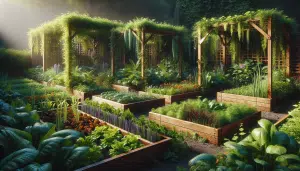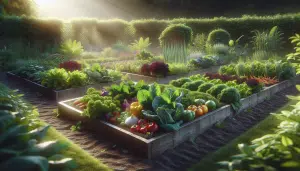You Can Transform Any Space With Vertical Gardens
Lily Carter October 16, 2025
Explore how vertical gardens redefine home and garden living, offering creative solutions for small spaces and enhancing air quality. This guide uncovers practical methods, plant varieties, and essential tips for designing and maintaining vibrant living walls, making sustainable gardening accessible for everyone.
Why Vertical Gardens Are Captivating Modern Homes
Vertical gardens are changing modern home and garden spaces in striking ways. Their popularity has soared as more people seek sustainable solutions for small apartments, urban patios, and even traditional backyards. Living walls can be installed indoors or outdoors, introducing creative green spaces where floor area is limited. The trend is about more than aesthetics; it represents a shift toward eco-friendly, space-saving home design solutions that benefit both homeowners and the planet. The ability of a vertical garden to infuse life into a room or courtyard appeals to those eager to experiment with unique botanical displays.
Homeowners appreciate how vertical gardens can foster improved air quality. Certain plant species absorb toxins, produce oxygen, and reduce the amount of indoor pollutants. This natural purification has prompted interior designers and homeowners alike to reconsider how plant choices impact the living environment. Besides visual intrigue, vertical gardens may contribute to physical and mental wellness by encouraging a calming atmosphere and supporting sustainable living practices.
Some choose vertical gardens for privacy or as charming green screens that soften outdoor seating areas without the need for construction. With sound-absorbing qualities and seasonal interest, living walls promote innovative landscaping for spaces both large and small. These attributes help maximize functionality and style in home and garden projects while championing environmental responsibility. Many find that even a single wall of greenery transforms how a home feels and functions for years to come.
Planning Your Vertical Garden: Steps to Success
Before starting a vertical garden, effective planning is crucial. Evaluate available light, temperature, humidity, and existing home or garden infrastructure. Without proper assessment, the garden might not thrive or could create unexpected maintenance woes. Consider whether your chosen location receives direct sunlight, partial shade, or primarily artificial light. This helps narrow down plant options—ferns, pothos, and spider plants, for example, adapt well indoors, while succulents and herbs often perform best in sunny outdoor conditions. Mapping out lighting and watering requirements ensures the garden suits both its environment and your lifestyle.
Design choices abound. Structures range from modular panels and hanging pockets to recycled wooden pallets and custom frames. For some, hydroponic systems offer a soil-free alternative, reducing mess and improving water efficiency. Wall stability is vital; the combined weight of planting materials, soil or substrate, and regular moisture can be significant. The support system should be anchored to surfaces that can withstand both weight and damp conditions. Consulting design guides or structural engineers for large projects is wise, particularly if you’re aiming for living walls above furniture.
Budgeting comes next. Modular kits and irrigation systems range in price, so compare options based on size and complexity. Many vertical gardening enthusiasts experiment with do-it-yourself containers made from upcycled materials. Costs vary depending on plant selection, so it’s helpful to prioritize resilient varieties during the first attempt. Planning in stages allows for gradual investment. As vertical gardens mature, they can be extended or replanted with minimal disruption, making them a versatile addition for evolving homes.
Picking the Right Plants for Your Vertical Garden
Plant selection sets the tone for every living wall. Shade-loving philodendrons, ferns, or bromeliads may thrive indoors, while petunias, succulents, herbs, and strawberries can create edible walls outside. Foliage texture, growth habit, and maintenance expectations all guide choice. Mixing trailing, upright, and spreading species builds a tapestry of color and form, giving living walls their signature lushness. Many opt for cascading varieties that spill over the edges, softening sharp lines and boosting biodiversity.
Avoid plants that demand completely different environmental conditions from one another. When each plant receives its ideal share of nutrients, water, and light, the whole garden flourishes. Drought-tolerant species minimize care, especially in sunny outdoor locations, while moisture-loving ferns or fittonias take center stage indoors. Choose slow growers to reduce maintenance, and consider native or pollinator-attracting varieties for outdoor projects. This approach not only creates a beautiful, sustainable display but also helps local wildlife thrive.
Some designers incorporate edible plants—lettuce, basil, mint—for a kitchen wall that’s both ornamental and practical. These selections keep culinary herbs close at hand while turning everyday gardening into an artistic home feature. Even novice gardeners can find success by blending robust houseplants or succulents, letting light conditions dictate plant groupings. With a thoughtful palette, even the smallest space becomes a living artwork that lifts the mood and sense of well-being for everyone in the space.
Installation Tips for a Reliable Living Wall
Installation can be straightforward if broken down step by step. Begin by preparing the support surface: ensure it is clean, moisture-resistant, and securely fixed to prevent future shifting. Next, mount the vertical gardening system—modular panels, stacked pots, or hydroponic rails—checking that all parts connect tightly and drainage is accommodated. For systems using soil, a waterproof membrane behind the structure is essential to block damp from reaching walls. Good drainage components prevent mold, root rot, and unwanted surface damage. Setting up before adding plants streamlines the process and avoids unnecessary stress on young sprouts.
Watering systems matter. Drip irrigation is efficient for many living walls, reducing manual effort and keeping moisture levels consistent. In indoor settings, watering should be monitored closely to avoid drips and puddles, while outdoor installations may benefit from rainwater collectors or built-in reservoirs. Always check for water leaks around the base and behind the structure—early issues are easiest to resolve before the root system becomes tangled and heavy. Looking ahead, automated watering can help busy households or gardeners maintain lush results with minimal intervention.
Finally, position taller or hardier plants at the top where moisture may be scarcest as water drips down. Fragile species often find their place lower on the wall, where humidity is higher and roots stay moist longer. Mixing textures and colors keeps the display lively and ensures no single plant dominates the arrangement. Seasonal checks of the structure anchors and hydrating schedule are key maintenance routines, especially as the vertical garden matures and grows heavier. Taking the time to install a wall correctly provides the foundation for years of thriving greenery.
Care and Maintenance for Thriving Vertical Gardens
Routine care maximizes the life and beauty of a vertical garden. Light pruning keeps growth balanced, while regular checks for pests like spider mites or fungus gnats protect plant health. Infrequent repairs to the structure may be needed if roots begin to overtake supports or moisture infiltrates behind the surface. Applying an organic fertilizer every few weeks—more or less depending on the plant mix—ensures robust foliage. Many integrated gardening systems make it easy to swap stressed or dying plants for new options, so a wall can be refreshed seasonally without major upheaval.
Proper watering is essential. Even with well-designed systems, upper levels may dry out faster than lower layers, especially in summer or heated indoor spaces. Use a moisture meter to monitor soil and adjust irrigation schedules as the garden settles in. During cooler months or rainy periods, reduce frequency to prevent soggy roots and unwanted fungal buildup. If pests appear, address them promptly using non-toxic sprays or removing affected leaves. Learning seasonal patterns in your vertical garden’s microclimate will fine-tune care routines and prevent setbacks.
Replanting and rearranging can be creative rituals. Gardens grown for edibles or cutting foliage need rotations every few months, while strictly decorative living walls might stay unchanged for years. Remove old leaves, trim aggressive vines, and inspect anchor points and trays for any weakness. Inviting children or guests to help can evolve maintenance into a fun, rewarding activity, thus deepening appreciation for both gardening and green living. Keeping a simple journal of care routines fosters confidence and makes every improvement visible over time.
Benefits of Vertical Gardens for Urban Living
Living walls bring significant benefits to urban lifestyles, particularly where ground space is tight. Besides aesthetic appeal, vertical gardens improve air quality by capturing dust, absorbing carbon dioxide, and releasing fresh oxygen. These natural air filters are particularly valued in cities with high vehicle emissions or minimal green infrastructure. Research supports that plants impact not only physical health but also cognitive performance—fresh air, increased humidity, and cooling effects combine to create more comfortable surroundings indoors and outdoors.
Noise reduction is another asset of vertical gardens. Dense layers of foliage can absorb and scatter sound, resulting in quieter homes and calmer courtyards. This function is advantageous in busy neighborhoods, along balconies facing main roads, or even within open-plan homes longing for extra privacy. Many apartment dwellers report that living walls encourage more frequent outdoor activity, which may boost mental wellness for residents of all ages. These small green oases can foster connections with neighbors and inspire wider community gardening projects.
Vertical gardens support biodiversity, providing habitats for pollinators like bees and butterflies even on city rooftops or balconies. Some municipalities incorporate living walls into building codes as part of broader sustainability goals aiming to reduce urban heat islands and manage stormwater. By making visible improvements to both air and lifestyle quality, these gardens rank high among solutions for resilient, happier urban living. Residents can enjoy the pleasures of gardening without sacrificing precious living space.
References
1. National Gardening Association. (n.d.). Vertical Gardening. Retrieved from https://garden.org/learn/articles/view/3650/
2. Environmental Protection Agency. (n.d.). Indoor Air Quality and Plants. Retrieved from https://www.epa.gov/indoor-air-quality-iaq/houseplants-and-indoor-air-quality
3. Royal Horticultural Society. (n.d.). Green walls and vertical gardening. Retrieved from https://www.rhs.org.uk/advice/profile?pid=180
4. University of Florida IFAS Extension. (n.d.). Vertical Gardens for Small Spaces. Retrieved from https://sfyl.ifas.ufl.edu/lawn-and-garden/vertical-gardening/
5. Green Roofs for Healthy Cities. (n.d.). Benefits of Green Walls. Retrieved from https://greenroofs.org/about-green-roofs/benefits/
6. Penn State Extension. (n.d.). Living Walls: Vertical Gardening at Home. Retrieved from https://extension.psu.edu/how-to-create-a-living-wall







